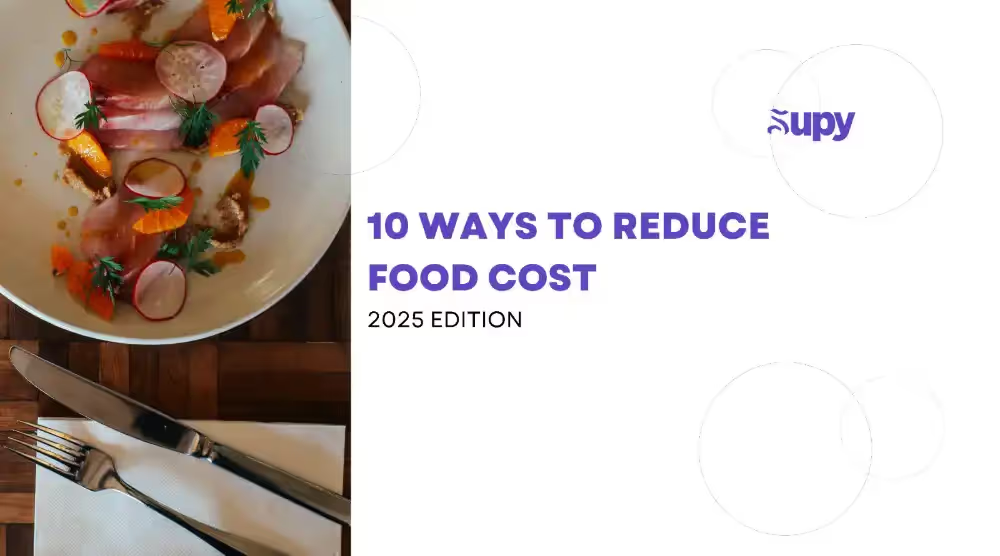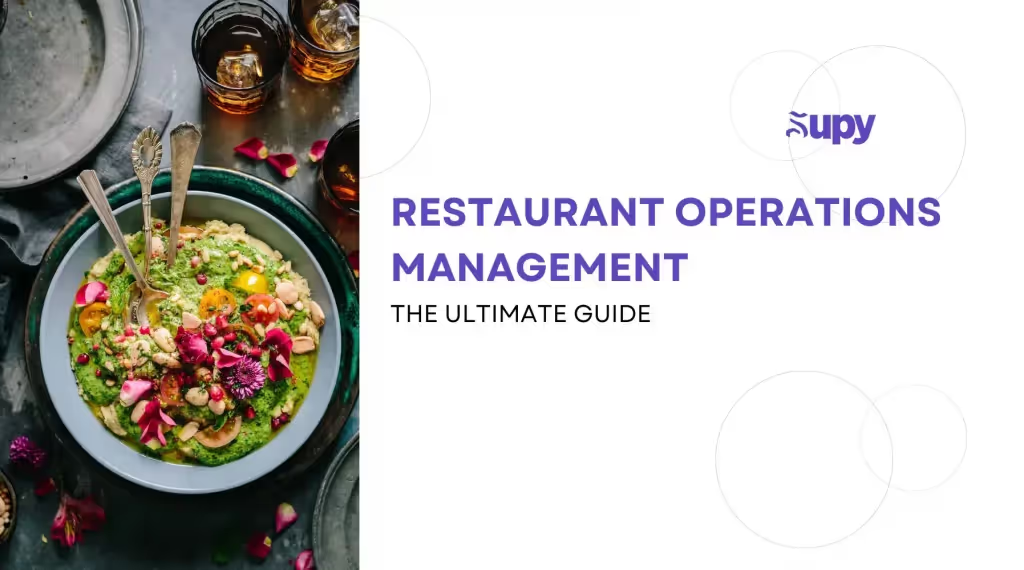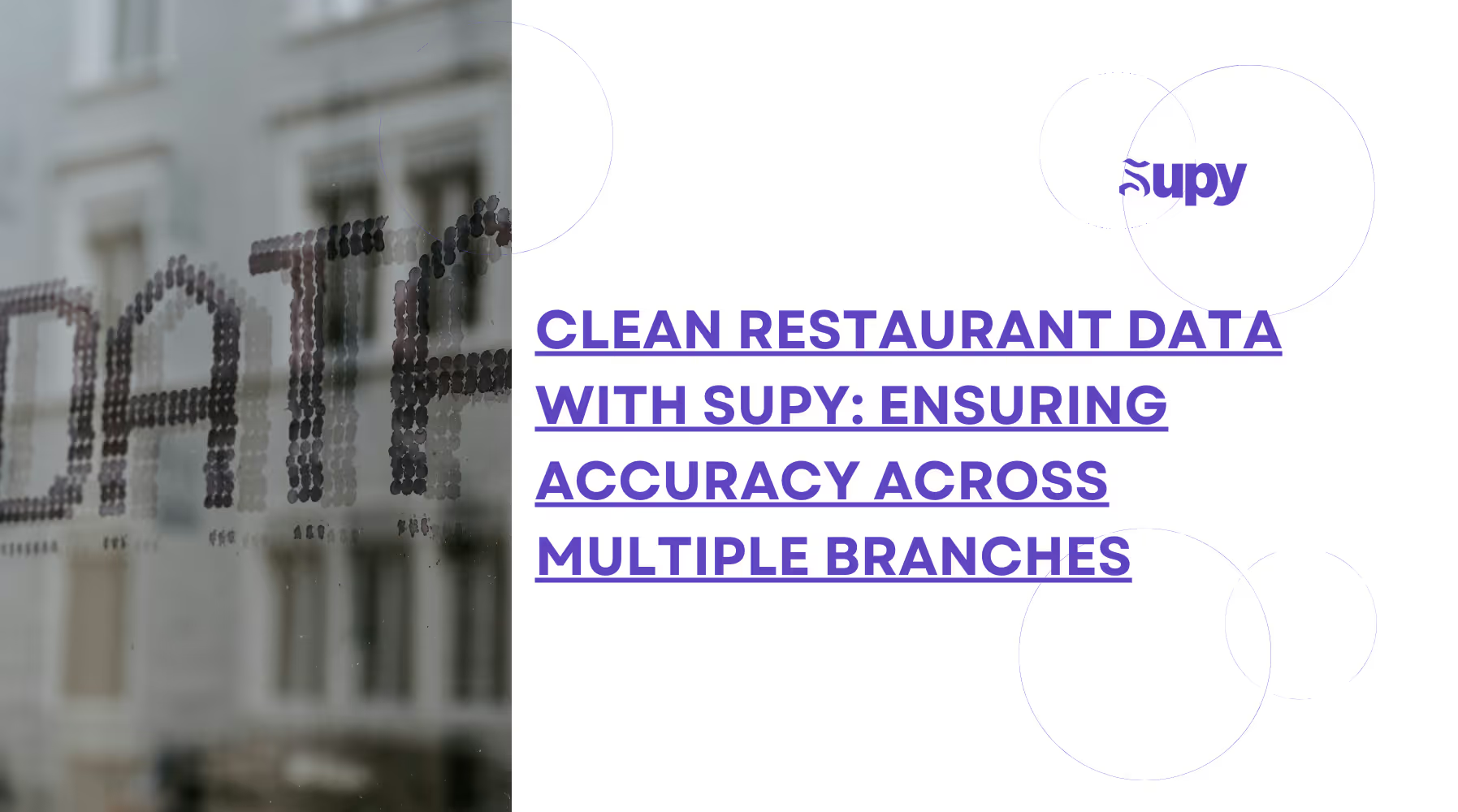Cutting Food Waste in Your Restaurant Chain: Cost-Saving Strategies
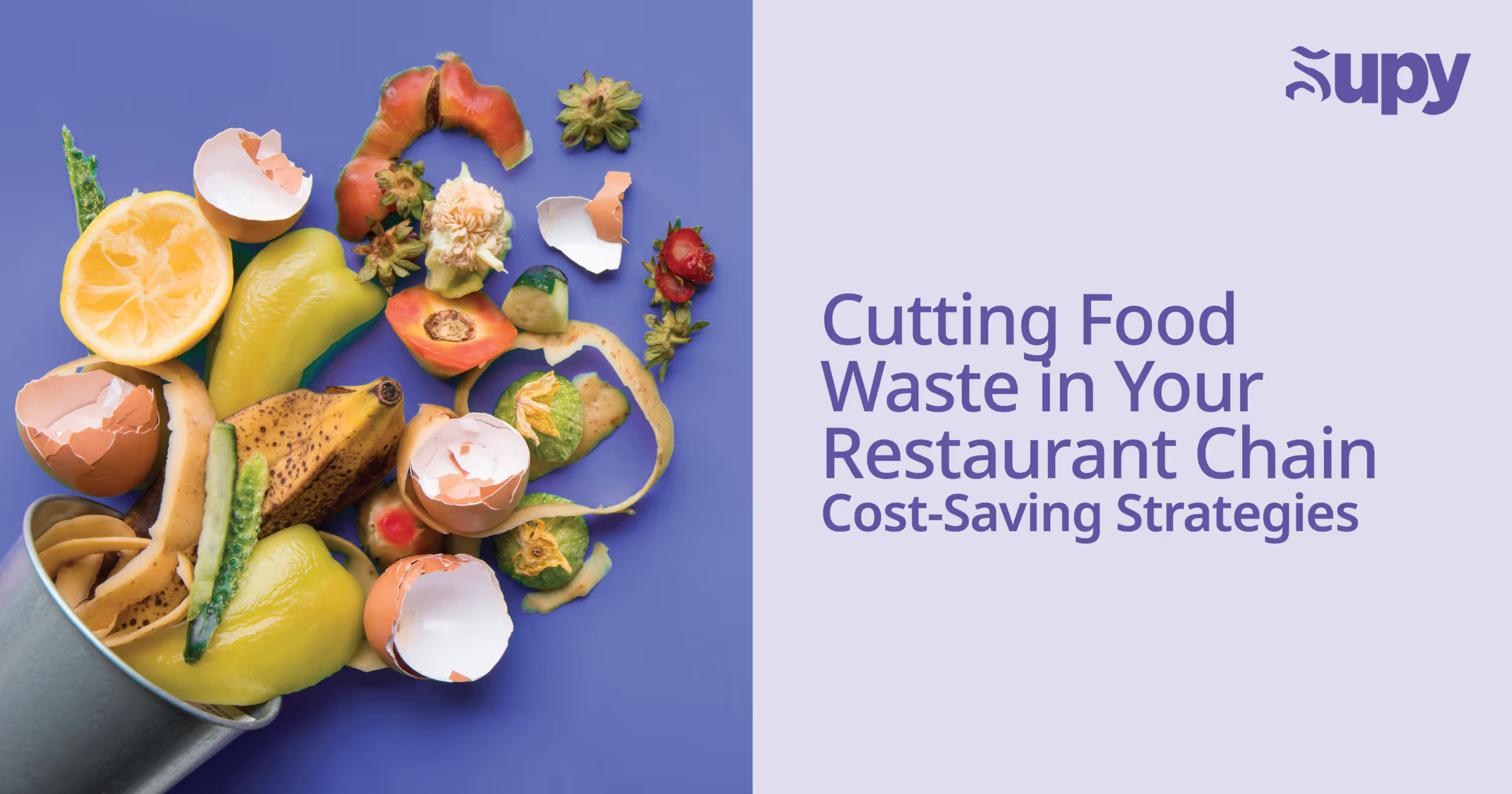
Food waste isn’t just an environmental concern – it’s a direct hit to your restaurant’s bottom line. For multi-location operators, the scale of the problem is multiplied across every branch. Imagine 10 kilograms of ingredients wasted per week at one outlet; in a 20-branch group, that’s a ton of product (literally) in the trash every month. Studies have found that restaurants globally generate hundreds of millions of tons of food waste annually, representing roughly 26% of all food waste worldwide. That wasted food carries a hefty price tag – about 4% to 10% of the food a restaurant buys ends up wasted on average. In other words, if you’re spending $50,000 a month on food across your chain, as much as $5,000 of that essentially gets thrown away.

Reducing food waste is one of the most immediate ways to cut costs and improve margins for a restaurant business. According to ReFED, every $1 invested in food waste reduction yields about $14 in savings 17 – a staggering 1300% return on investment for initiatives that tackle waste. Beyond the financial gains, minimizing waste can even boost revenue: consumers are increasingly eco-conscious, with 91% preferring to buy from restaurants that actively reduce food waste. It’s a win-win: you save money and build a stronger reputation by slashing waste across your operations.
In this guide, we’ll explore practical, operator-tested strategies to cut food waste in a multi-unit restaurant organization. From smarter inventory management to staff training and menu engineering, these tips will help you tighten up your food usage and stop throwing money into the garbage bin.
Track and Measure All Wastage
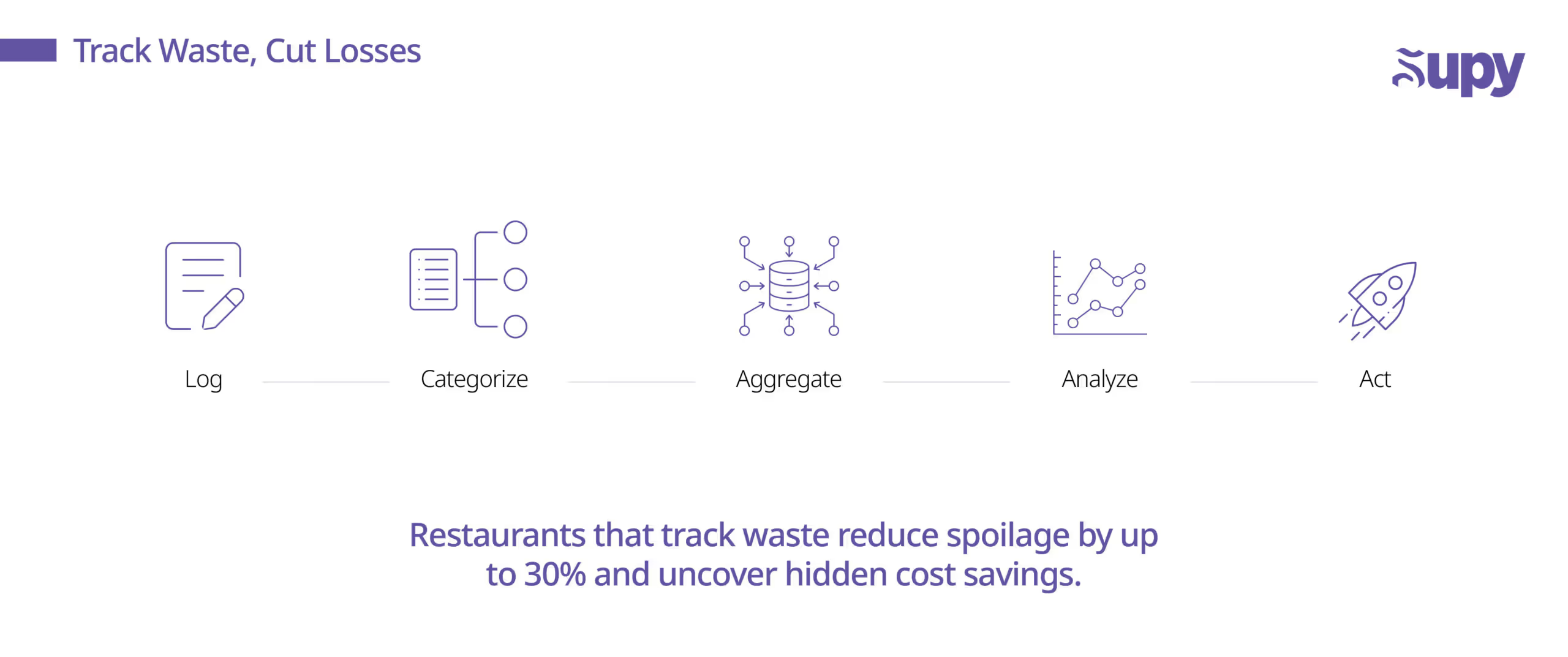
You can’t fix what you don’t measure. The first step to reducing waste is to track every instance of food waste across your restaurants. Implement a clear system for logging waste at each branch – whether it’s a daily waste sheet or (better yet) a module in your inventory software. Staff should record what was wasted, how much, and why (e.g. expired produce, overcooked batch, customer returned dish). This data is eye- opening. Many operators are surprised to discover where the bulk of their waste is coming from – it could be trimming losses in prep, or a particular appetizer that gets sent back half-eaten 30% of the time.
Make waste tracking part of the daily closing routine for each kitchen. For example, Supy’s SOP requires branches to log any wastage events with the proper category (expired, damaged, etc.) and quantity. Keeping a daily waste log ensures that no tossed food goes unnoticed. Over time, you can aggregate this data to pinpoint trends: maybe Branch #5 consistently wastes more chicken each week than others – why? Perhaps their par levels are too high or demand is lower. With the numbers in hand, you can investigate and act.
Optimize Inventory Ordering and Storage
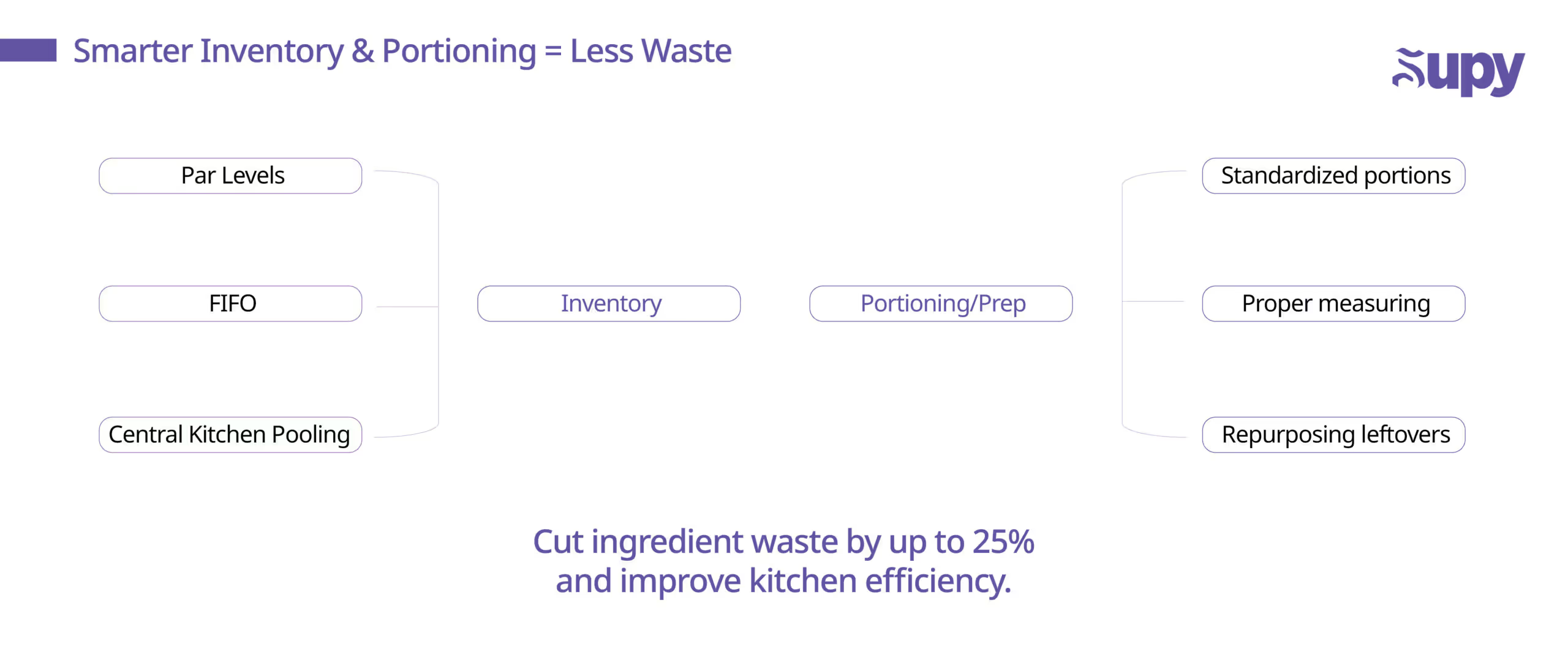
A significant chunk of restaurant waste comes from ingredients that spoil before they’re ever used. The culprit is often over-ordering or poor stock rotation. To avoid this, use your inventory management system to dial in precise ordering for each location. Base orders on recent sales and realistic forecasts rather than “gut feel.” For instance, if one cafe branch consistently uses 20 crates of tomatoes a week, don’t let them order 30 “just in case.” Those extra 10 crates are likely to end up in the trash. Set par levels and stick to them – your system can help enforce this by flagging orders above a location’s normal usage.
Also pay attention to FIFO (First-In, First-Out) in storage. Ensure that older stock is always used before newly delivered stock. Train each kitchen team to promptly move incoming goods to the back of shelves and bring older items to the front. If you find cases of produce consistently spoiling, it could be a sign that FIFO isn’t being followed and newer stock is piling on top of old. Regular internal audits of walk-ins and dry storage can catch these issues. Some chains even designate a “freshness champion” at each store to check rotation and expiration dates weekly. The goal is to never let good food go bad due to neglect.
Finally, evaluate where you might be able to consolidate inventory. If you have multiple branches in the same city, consider pooling certain perishable stock at a central kitchen or hub, if feasible, and delivering out to stores as needed. This way, one location with a slow week won’t just watch produce rot on the shelf – you can redistribute it. It requires tight coordination, but it’s an advanced strategy that can significantly cut spoilage for multi-units.
Train Staff on Portioning and Prep

A lot of waste occurs during food preparation and serving. Overly generous portioning, inefficient prep techniques, or simple mistakes (like burning a batch) can generate heaps of trash. Staff training can dramatically reduce these forms of waste. Start with portion control: make sure every cook knows the exact recipe yields and portion sizes for each dish. Using proper measuring tools – scales, portion scoops, ladles – should be non-negotiable. When recipes are followed meticulously, you avoid the “extra scoop” or the plate that comes back with half the food uneaten because it was too large a serving.
Additionally, train your prep cooks on techniques to maximize yield. For example, show them how to trim meats and vegetables efficiently to minimize what gets thrown out. A bit of knife skill improvement can turn what used to be trash into a usable product. Emphasize the importance of repurposing excess as well: yesterday’s roasted chicken can become today’s soup special, vegetable peels can flavor stocks, day-old bread can become croutons. In one UK survey, overproduction and lack of employee training were cited as major causes of restaurant waste. Investing time in teaching your team can pay off in significantly lower waste.
Finally, make waste reduction part of your kitchen culture. Some restaurants literally weigh the trash each day and post the numbers to motivate friendly competition between teams. Others create incentive programs where if the kitchen stays under a certain waste percentage for the month, the staff get a reward. Find what works for your group, but keep the crew engaged – when your line cooks and servers treat waste reduction as a shared mission, the results will follow.
Engineer Your Menu with Waste in Mind
Your menu design can either contribute to waste or help prevent it. Too many menu items, especially those with unique ingredients that aren’t used elsewhere, can lead to spoilage. Streamline your offerings to focus on high-movers and dishes that share ingredients. This way, your inventory turns over faster and ingredients get fully utilized. If an item isn’t selling well, it might be time to remove or reinvent it rather than let its components keep expiring on the shelf.
Also consider the versatility of ingredients when designing new menu items. Can that surplus butternut squash be used in a soup and a side dish? Can you incorporate trim and byproducts creatively (like a “chef’s special” fried rice using yesterday’s cooked veggies and protein)? Many successful restaurant groups have a practice of introducing limited-time specials specifically aimed at using up excess inventory. It’s a savvy way to excite customers while clearing out stock that might otherwise become waste.
Embrace Technology for Waste Reduction

Modern restaurant tech can be a powerful ally in the fight against waste. Inventory management software not only tracks stock levels but can also integrate with your POS to analyze sales patterns and waste data. By identifying the gap between what was sold and what was used (the variance), these systems help flag problem areas. For example, if the system shows you should have 10kg of cheese on hand but only 7kg is in stock, that 3kg variance is a red flag to investigate (theft? unrecorded waste? over- portioning?). Many platforms can generate variance reports automatically, so you don’t have to crunch the numbers manually.
Some tools also offer demand forecasting using AI, which can adjust suggested order quantities based on historical patterns, seasonal trends, or even weather. This helps prevent over-ordering that leads to spoilage. Suppliers are also getting on board – some digital procurement systems alert you if you’re ordering significantly more of an item than usual (prompting you to double-check before committing to 10 cases of lettuce that you might not actually use in time).
Even simple tech tools like automated temperature sensors in fridges can prevent waste by alerting staff to equipment failures before everything inside spoils. And don’t overlook the power of analytics: if you consolidate all your waste tracking data, inventory variance, and sales info in one dashboard, it becomes much easier to see the big picture and drill down into specific problems. One chain discovered via analytics that a particular sauce was being over-produced across multiple outlets, leading to large daily throwaways – they adjusted the recipe batch size and saved thousands of dirhams a month.
Partner with Food Waste Initiatives
No matter how efficient you become, there will always be some unavoidable waste – trimmings, day-olds, etc. Rather than sending these to the landfill, consider partnering with local organizations to put them to use. Food banks and charities in many cities will accept surplus prepared foods or ingredients (within safety guidelines) to redistribute to those in need. Some companies also specialize in collecting organic waste for composting or biofuel, which can reduce your disposal costs and environmental impact.
Getting involved in such initiatives can bolster your brand image. It shows that your restaurant cares about the community and sustainability, which resonates with the growing segment of eco-conscious consumers. Be sure to document and communicate these efforts – for example, “In June, our restaurant group donated 500 kg of excess food to local shelters” makes for great social media content and staff pride.
At the same time, these partnerships might inspire you to further reduce waste at the source. When you see how much perfectly edible food was being thrown out (now being donated), it reinforces the importance of everything we discussed: smarter ordering, better training, and creative repurposing. Ultimately, the goal is to have less surplus to donate because you’re wasting less to begin with – but until you get there, helping others with your excess is a worthy stopgap.
Food waste is one of the most solvable cost challenges in restaurants. By focusing on inventory discipline, staff training, and smart menu design, multi-unit operators can save tens of thousands annually that would otherwise quite literally go to waste. To see how technology can give you an edge in waste reduction and cost control, schedule a Supy demo today. And for more ideas on cutting waste, check out our blog “10 Tips to Reduce Restaurant Food Waste” for additional insights and best practices.




